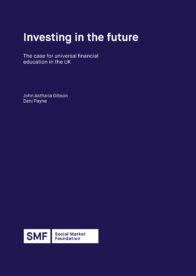Politicians across the spectrum are keen for education to provide young people with key life skills, yet financial literacy among young people in the UK remains inadequate. This report looks at how financial education can be delivered more effectively in the UK.
KEY POINTS
- Britain has one of the lowest rates of financial literacy compared to similarly advanced economies. Only 47% of adults score five or more out of seven on financial knowledge questions, compared to the OECD average of 62%.
- Financial education is already a part of the English secondary school curriculum, but for financial education to make a difference it is important to start young –socioeconomic inequalities in financial understanding can be seen at age 11.
- Current rates of financial literacy among young people are low. Only 1% of primary school teachers believing that their pupils possess adequate financial skills.
- Embedding financial education into the primary school curriculum is the most effective method of delivering it at scale, but this is just a first step. A lack of time, resources, low prioritisation and lack of expertise all need to be overcome.
RECOMMENDATIONS
- Financial education should be integrated into the English primary school curriculum and taught across subjects using a ‘whole school approach’.
- The Department for Education and Ofsted should set financial literacy as a priority area for schools.
- The Department for Education should set up a central hub of accredited teacher training programmes and teaching resources.
- Training on delivering financial education effectively should be embedded into Initial Teacher Training programmes.
- The Money and Pensions Service should work with the Department for Education to calculate long-term funding required for effective financial education at primary level, provided by the Dormant Assets Scheme.
- The government should support the Money and Pensions Service to develop a financial literacy data strategy.

DOWNLOAD THE REPORT: PDF
Kindly sponsored by

